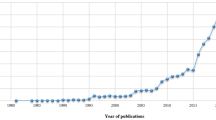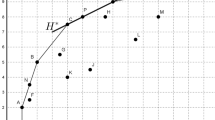Abstract
This paper reports on an innovative combination of hard and soft methods—soft systems methodology (SSM) with data envelopment analysis (DEA). Problems in defining and agreeing appropriate inputs and outputs for DEA led to the use of SSM as a way or producing a comprehensive and systemic database of performance indicators. The contributions of the paper are: the use of SSM to improve DEA specifications; conceptual clarifications within both SSM and DEA; and an innovative example of multimethodology. These developments are illustrated through a study evaluating the performance of the basic research institutes of the Chinese Academy of Sciences.





Similar content being viewed by others
References
Abbott M and Doucouliagos C (2003). The efficiency of Australian universities: A data envelopment analysis. Econ Educ Rev 22: 89–97.
Beasley J (1995). Determining teaching and research efficiencies. J Opl Res Soc 46: 441–452.
Brockett P, Cooper W, Lasdon L and Parker B (2005). A note extending Grosskopf, Hayes, Taylor and Weber ‘Anticipating the consequences of school reforms: A new use of DEA'. Socio-Econ Plann Sci 39: 351–359.
Campbell P (2004). Messages to China from the west. Nature 428: 203.
CAS (2005). Chinese Academy of Sciences, http://english.cas.cn/Eng2003/page/home.asp.
Casu B, Shaw D and Thanassoulis E (2005). Using a group support system to aid input-output identification in DEA. J Opl Res Soc 56: 1363–1372.
Checkland P (1981). Systems Thinking, Systems Practice. Wiley: Chichester.
Checkland P (1999). Systems Thinking, Systems Practice: Includes a 30-Year Retrospective. Wiley: Chichester.
Checkland P and Scholes J (1990). Soft Systems Methodology in Action. Wiley: Chichester.
Checkland P and Wilson B (1980). ‘Primary task' and ‘issue-based' root definitions in systems studies. J Appl Syst Anal 7: 51–55.
Checkland P, Forbes P and Martin S (1990). Techniques in soft systems practice part 3: monitoring and control in conceptual models and evaluation studies. J Appl Syst Anal 17: 29–37.
Connell N (2001). Evaluating soft OR: some reflections on an apparently ‘unsuccessful’ implementation using a soft systems methodology (SSM) based approach. J Opl Res Soc 52: 150–160.
Cooper W (2000). Data envelopment analysis. In: Gass S. and Harris M. (eds). Encyclopedia of Operations Research and Management Science. Kluwer: Boston, pp. 183–190.
Cooper W, Seiford L and Kaoru T (2000). Data Envelopment Analysis. Kluwer: New York.
Crespi G and Geuna A (2005). Modelling and measuring scientific. production: Results for a panel of OECD countries. SEWPS133, SPRU, Brighton.
Geuna A and Martin B (2003). University research evaluation and funding: an international comparison. Minerva 41: 277–304.
Gibbons M and Georghiou L (1987). Evaluation of Research. A Selection of Current Practices. OECD: Paris.
Grosskopf S, Hayes K, Taylor L and Weber W (1999). Anticipating the consequences of school reform: A new use of DEA. Mngt Sci 45: 608–620.
Hogan P, Jaska P and Raja M (2003). Combining soft systems methodology techniques (SSM) and data envelopment analysis in an exploratory analysis of the use of technology consultants for IS implementation. Int J Comput Syst Signals 4: 5–21.
Korhonen P, Tainio R and Wallenius J (2001). Value efficiency analysis of academic research. Eur J Opl Res 130: 121–132.
Li X (2005). Practice and thoughts on performance evaluation in China's state-run institutes of scientific research. Bull Chinese Acad Sci 20: 395–398.
Meng W (2006). Studies of data envelopment analysis and its application in basic research evaluation. PhD, University of Kent, Canterbury.
Meng W, Liu W and Hu Z (2006). Efficiency evaluation of basic research in China. Scientometrics 69: 85–101.
Meng W, Zhang D and Liu W (2007). Multi-level DEA approach in research evaluation. Working Paper 140, Kent Business School, Canterbury.
Mingers J (1995). Using Soft Systems Methodology in the design of information systems. In: Stowell F. (ed). Information Systems Provision: The Contribution of Soft Systems Methodology. McGraw-Hill: London, pp. 18–50.
Mingers J (2003). A classification of the philosophical assumptions of management science methods. J Opl Res Soc 54: 559–570.
OECD (1997). The evaluation of scientific research: Selected experiences. OCDE/GD(97)194, OECD, Paris.
Takamura Y and Tone K (2003). A comparative site evaluation study for relocating Japanese government agencies out of Tokyo. Socio-Econ Plann Sci 37: 85–102.
Thanassoulis E (2001). Introduction to the Theory and Application of Data Envelopment Analysis. Kluwer: New York.
White L (2006). Evaluating problem-structuring methods: developing an approach to show the value and effectiveness of PSMs. J Opl Res Soc 57: 842–855.
Yang T and Kuo C (2003). A hierarchical AHP/DEA methodology for the facilities layout design problem. Eur J Opl Res 147: 128–136.
Author information
Authors and Affiliations
Corresponding author
Rights and permissions
About this article
Cite this article
Mingers, J., Liu, W. & Meng, W. Using SSM to structure the identification of inputs and outputs in DEA. J Oper Res Soc 60, 168–179 (2009). https://doi.org/10.1057/palgrave.jors.2602542
Received:
Accepted:
Published:
Issue Date:
DOI: https://doi.org/10.1057/palgrave.jors.2602542




